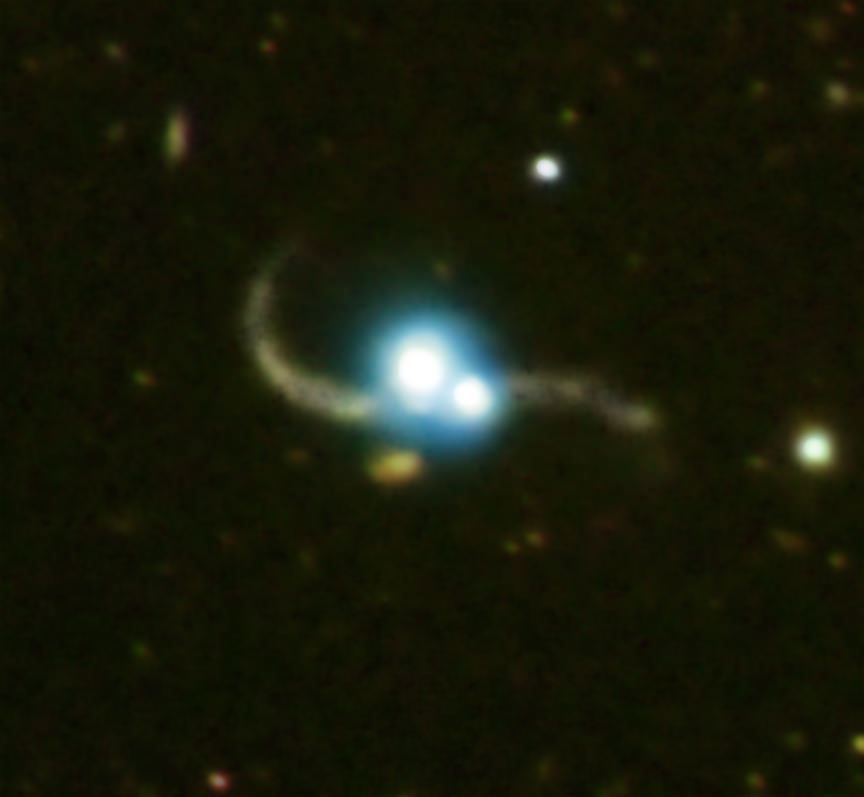[/caption]
Excellent teamwork by astronomers working in two different wavebands – x-ray and optical – has led to the discovery of a binary quasar being created by a pair of merging galaxies.
“This is really the first case in which you see two separate galaxies, both with quasars, that are clearly interacting,” says Carnegie astronomer John Mulchaey who made observations crucial to understanding the galaxy merger.
“The model verifies the merger origin for this binary quasar system,” Thomas Cox, now a fellow at the Carnegie Observatories, says, referring to computer simulations of the merging galaxies he produced. When Cox’s model galaxies merged, they showed features remarkably similar to what Mulchaey observed in the Magellan images. “It also hints that this kind of galaxy interaction is a key component of the growth of black holes and production of quasars throughout our universe,” Cox added.
“Just because you see two galaxies that are close to each other in the sky doesn’t mean they are merging,” says Mulchaey. “But from the Magellan images we can actually see tidal tails, one from each galaxy, which suggests that the galaxies are in fact interacting and are in the process of merging.”
As Universe Today readers know, quasars are the extremely bright centers of galaxies surrounding supermassive black holes, and binary quasars are pairs of quasars bound together by the mutual gravitation of the two host galaxies’ nuclei. Binary quasars, like other quasars, are thought to be the product of galaxy mergers. Until now, however, binary quasars have not been seen in galaxies that are unambiguously in the act of merging. But images of a new binary quasar from the Carnegie Institution’s Magellan telescope in Chile show two distinct galaxies with tails produced by tidal forces from their mutual gravitational attraction.
Supermassive black holes are to be found in the nuclei of most, if not all, large galaxies, such as our galaxy the Milky Way. Because galaxies regularly interact and merge, astronomers have concluded that binary supermassive black holes have been common in the Universe, especially during its early history (when galaxy mergers were far more common). Supermassive black holes can only be detected as quasars – which are one kind of highly luminous active galactic nucleus (AGN) – when they are actively accreting matter, a process that releases vast amounts of energy across the entire electromagnetic spectrum. A leading theory of ordinary AGNs is that galaxy mergers trigger accretion, creating quasars in both galaxies (AGNs in the hearts of the giant elliptical galaxies in rich clusters are thought to be fueled by a different mechanism, cooling flow). Because most such mergers would have happened in the distant past, binary quasars and their associated galaxies are very far away and therefore difficult for most telescopes to resolve.
The binary quasar, named SDSS J1254+0846, was initially detected by the Sloan Digital Sky Survey, a multi-year, large scale astronomical survey of galaxies and quasars. Further observations by Paul Green of the Harvard-Smithsonian Center for Astrophysics and colleagues using NASA’s Chandra’s X-ray Observatory and telescopes at Kitt Peak National Observatory in Arizona and Palomar Observatory in California strongly suggest that the object was likely a binary quasar in the midst of a galaxy merger. Carnegie’s Mulchaey then used the 6.5 meter Baade-Magellan telescope at the Las Campanas observatory in Chile to obtain deeper images and more detailed spectroscopy of the merging galaxies.
The Astrophysical Journal paper on this object is: “SDSS J1254+0846: A Binary Quasar Caught in the Act of Merging” (Paul J. Green et al 2010 ApJ 710 1578-1588; arXiv:1001.1738 is the preprint).
Source: Carnegie Institution for Science


In case someone asks, the two objects are 4.6 billion light-years from Earth — which means that the light from those objects are as old as the Earth itself. One wonders: what alien worlds reside those galaxies?
They would have an amazing view of the night sky, if they weren’t fried by destructive quasar awesomeness!
Nice article Jean.
BTW Think you mean ‘has led to..’ instead of ‘has lead to’
Thanks andyf!
And I fixed it.